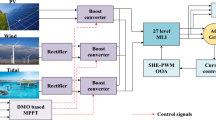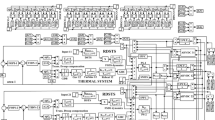Abstract
An adaptive observer with a decreased order is proposed in this study for use in the hardware implementation of a 3-p, 3-w distribution static compensator (DSTATCOM), which extracts grid parameters. The DSTATCOM is inculcated for attaining various functions like reactive power compensation, mitigation of current source related harmonics accompanied by the self-sufficient DC bus. A reduced order-based adaptive observer is incorporated to determine grid parameters which work under the polluted condition and does not depend on the linearization of PD output using PLL. A Lyapunov function is incorporated for ensuring the proper tracking of grid parameters under the distorted conditions which makes the system adaptive. In order to achieve the fine tuning of proportional integral gains which preserves the DC bus voltage to its craved value, Gray Wolf Optimizer is employed which utilizes very less memory and requires very less parameters reducing the computation time offering faster response in achieving the values with lower settling and rise time in comparison with manual method. Simulation in MATLAB and hardware prototy** in the laboratory with the aid of a digital signal processor are used to evaluate the control algorithm's performance, with the findings validating the control algorithm's performance.












Similar content being viewed by others
Availability of data and materials
No Availability of data or any other materials.
References
Abbas AS, El-Ela A, El-Sehiemy R, Elbaset AA (202s3) Power quality enhancement using artificial intelligence techniques. CRC Press Taylor and Francis Group, Boca Raton
Kumar P, Arya SR, Mistry KD, Giri AK (2021) Hybrid self-learning controller for restoration of voltage power quality using optimized multilayer neural network. Int J Circuit Theory Appl 49(12):4248–4273
Giri AK, Arya SR, Guerrero JM, Kumar S (2023) Power quality: infrastructures and control. Springer, Cham
Akagi H, Hirokazu Watanabe E, Aredes M (2007) Instantaneous power theory and applications to power conditioning. John Wiley and Sons, New Jersey
Qureshi A, Giri AK, Arya SR, Padmanaban S (2021) Power conditioning using DSTATCOM in a single-phase SEIG-based isolated system. Chinese J Electr Eng 104:111–127
Kundu S, Singh M, Giri AK (2024) Adaptive control approach-based isolated microgrid system with alleviating power quality problems. J Electr Power Compon Syst 52(7):1219–1234
Shingote S, Shejwalkar A, Swain S (2023) Comparative analysis for state-of-charge estimation of lithium-ion batteries using non-linear kalman filters, In: Proceedings of 3rd international conference on sustainable energy and future electric transportation
Liu Z, Bornhorst N, Berg SW, Braun M (2020) A grid equivalent based on artificial neural network in power systems with high penetration of distributed generation with reactive power control, In: Conference on sustainable energy supply and energy storage systems
Ge Y, Yang L, Ma X (2021) A harmonic compensation method for SPMSM sensorless control based on the orthogonal master-slave adaptive notch filter. IEEE Trans Power Electron 36(10):11701–11711
Xu J, Qian H, Qian Q, **e S (2022) Modeling, stability, and design of single-phase SOGI-based phase-locked loop considering the frequency feedback loop effect. IEEE Trans Power Electron 38(1):987–1002
Park Y, Sul S, Kim W, Lee H (2014) Phase-Locked Loop based on an observer for grid synchronization. IEEE Trans Ind Appl 50(2):1256–1265
Ciobotaru M, Teodorescu R, Blaabjerg F (2006) A New single-phase PLL structure based on second order generalized integrator, In: 37th IEEE power electronics specialists conference
Srikakolapu J, Arya S, Maurya R (2021) Distribution static compensator using an adaptive observer based control algorithm with salp swarm optimization algorithm. CPSS Trans Power Electr Appl 6(1):52–62
Chen D, Wang J, Zhou L (2023) Adaptive second-order active-flux observer for sensorless control of PMSMs with MRAS-Based VSI Non-Linearity comparison. IEEE J Emerg Sel Top Power Electr 11:3076–3086
Jenkins B, Krupadanam A, Annaswamy A (2020) Fast adaptive observers for battery management systems. IEEE Trans Control Syst Technol 28(3):776–789
Kudva P, Narendra K (1973) Synthesis of an adaptive observer using Lyapunov’s direct method. Int J Control 18(6):1201–1210
Li G, Wen X, Wang Z (2023) Harmonic detection of power grid based on the optimal reduced-order observer, In: Proceedings of 42nd chinese control conference, pp. 1–6
Yang S, Ajjarapu V (2010) A speed-adaptive reduced-order observer for sensorless vector control of doubly fed induction generator-based variable-speed wind turbines. IEEE Trans Energy Convers 25(3):891–900
Yan J, Yang G, Wang Y (2022) Dynamic reduced-order observer-based detection of false data injection attacks with application to smart grid systems. IEEE Trans Industr Inf 18(10):6712–6722
Guo X, Huang S, Peng Y, Lu K, Huang S, Luo D, Wu X (2023) An improved sliding mode control for PMSM drives based on new variable rate reaching law with adaptive reduced-order PI observer. IEEE Trans Transp Electrif 9(3):4503–4516
Lu Y, **ao W, Lu D (2022) Optimal dynamic and steady-state performance of PV-interfaced converters using adaptive observers. IEEE Trans Circuits Syst-II, Express Briefs 69(12):4909–4913
Munphal S, Suwankawin S (2022) A Position-sensorless control of doubly fed induction machine by stator-equation-based adaptive reduced-order observer. IEEE Trans Power Electron 37(12):15186–15208
Dai Z, Lin H, Tian Y, Yao W, Yin H (2016) Accurate voltage parameter estimation for grid synchronization in single-phase power systems. J Power Electr 16(3):1067–1075
Alam SJ, Arya SR (2021) Compensation of power quality problems through UPQC-S using enhanced complex coefficient filter. Int Trans Electr Energy Syst. https://doi.org/10.1002/2050-7038.12729
Bozorg-Haddad O (2018) Advanced optimization by nature-inspired algorithm. Springer, Singapore
Li X, Luk KM (2020) The Grey Wolf optimizers and its applications in electromagnetics. IEEE Trans Antennas Propag 68(3):2186–21975
Zhao Y, Wu Q, Li H, Ma S, He P, Zhao J, Li Y (2019) Optimization of thermal efficiency and unburned carbon in fly ash of coal-fired utility boiler via grey wolf optimizer algorithm. IEEE Access 7:114414–114425
Daneshvar S, Mohajer P, Mazinani S (2019) Energy-efficient routing in WSN: a centralized cluster-based approach via Grey Wolf Optimizer. IEEE Access 7:170019–170031
Funding
No Funding received for this work.
Author information
Authors and Affiliations
Contributions
(1) Hardik M. Pandya is written manuscript, taken results and analyzed the system. (2) Sabha Raj Arya is designed the system, corrected and checked the manuscript.
Corresponding author
Ethics declarations
Competing interests
The authors declare that they have no competing interests.
Ethical approval
We hereby declare that the work submitted by us is original and confirm that this paper has not been submitted to any other journals for review or any other process and also all authors have contributed significantly for this manuscript.
Additional information
Publisher's Note
Springer Nature remains neutral with regard to jurisdictional claims in published maps and institutional affiliations.
Appendix
Appendix
1.1 Parameter for the simulation of reduced order observer-based FLL on DSTATCOM for PFC Mode
AC supply: 3 phase, 50 Hz; 420 V (line to line), Nonlinear Load: Three-phase diode bridge rectifier with RL load where R = 10 ohms and L = 100mH; Passive ripple filter: \(R_{{\text{f}}}\) = 5 Ω, \(C_{{\text{f}}}\) = 10 \(\mu F\); dc link reference voltage: 700 V; dc link capacitor (\(C_{{{\text{dc}}}}\)): 5000 \(\mu F\); Intermediate filter inductor: \(L_{{\text{f}}}\) = 3mH; Low pass filter (LPF) cut off frequency: 8 Hz, Gains of dc link controller: \(k_{p}\) = 3 and \(k_{i}\) = 1.5
1.2 Parameter for the simulation of reduced order observer-based FLL on DSTATCOM for ZVR Mode
AC supply: 3 phase, 50 Hz; 420 V (line to line), Nonlinear Load: Three-phase diode bridge rectifier with RL load where R = 10 ohms and L = 100mH; Passive ripple filter: \(R_{{\text{f}}}\) = 5 Ω, \(C_{{\text{f}}}\) = 10 \(\mu F\); dc link reference voltage: 700 V; ac link reference voltage: 339 V; dc link capacitor (\(C_{{{\text{dc}}}}\)): 5000 \(\mu F\); Intermediate filter inductor: \(L_{{\text{f}}}\) = 3mH; Low pass filter (LPF) cut off frequency: 8 Hz, Gains of dc link controller: \(k_{p}\) = 2.9 and \(k_{i}\) = 1.9
1.3 Parameter for hardware setup of reduced order observer-based FLL on DSTATCOM
AC supply: 3 phase, 50 Hz; 110 V (line to line), Nonlinear Load: Three-phase diode bridge rectifier with RL load where R = 30 ohms and L = 100mH; Passive ripple filter: \(R_{{\text{f}}}\) = 5 Ω, \(C_{{\text{f}}}\) = 10 \(\mu F\); dc link reference voltage: 200 V; Intermediate filter inductor: \(L_{{\text{f}}}\) = 4mH; Low pass filter (LPF) cut off frequency: 10 rad/s; Load side inductance = 2mH.
1.4 Selection of DC link
The threshold value of the DC link voltage \(V_{{{\text{dc}}}}\) of the DSTATCOM must be greater than the twice the maximum value of the phase voltage in the distribution system. The DC bus voltage can be computed as,
Here, line to line voltages are taken as 420 V, m is the modulation index with the value of 1. Substituting these values in above equation, we get,
1.5 Selection of inductor
The choice of the AC inductance \(L_{{\text{f}}}\) for voltage source converter is determined by the ripple content of the current \(i_{{{\text{ripple}}}}\) which is to be considered as 15%, switching frequency \(f_{{{\text{sw}}}}\) which is taken as 1.8 kHz, and DC line voltage \(V_{{{\text{dc}}}}\), and it is mathematically expressed as,
where a is an overloading factor with the value 1.2, substituting all the values of the parameters in the above equation, the value of the inductor for VSC can be given as,
Rights and permissions
Springer Nature or its licensor (e.g. a society or other partner) holds exclusive rights to this article under a publishing agreement with the author(s) or other rightsholder(s); author self-archiving of the accepted manuscript version of this article is solely governed by the terms of such publishing agreement and applicable law.
About this article
Cite this article
Pandya, H.M., Arya, S.R. Control of DSTATCOM using reduced order-based adaptive observer under grid supply with optimized PI gains. Electr Eng (2024). https://doi.org/10.1007/s00202-024-02486-6
Received:
Accepted:
Published:
DOI: https://doi.org/10.1007/s00202-024-02486-6




